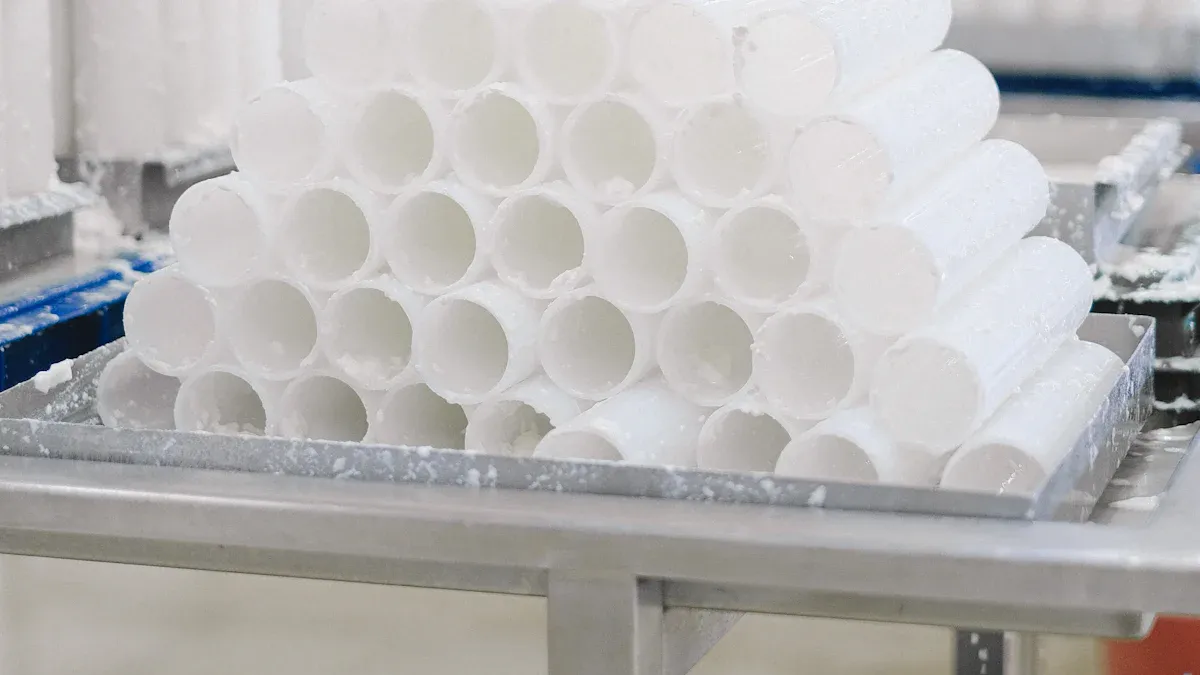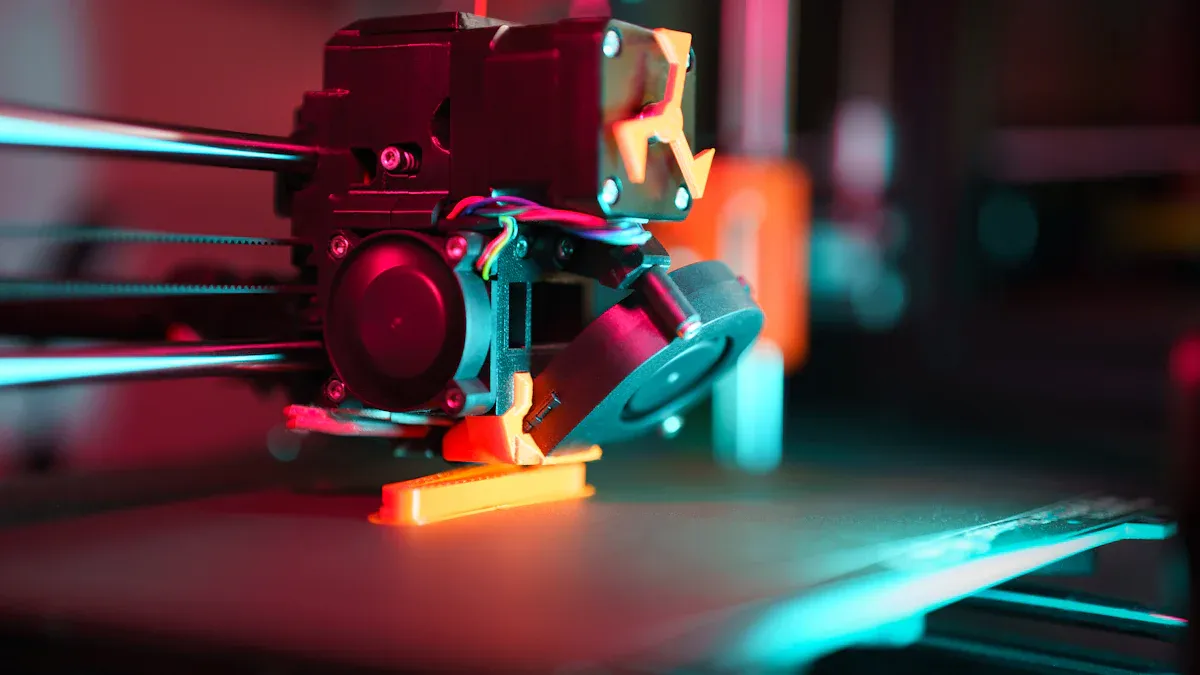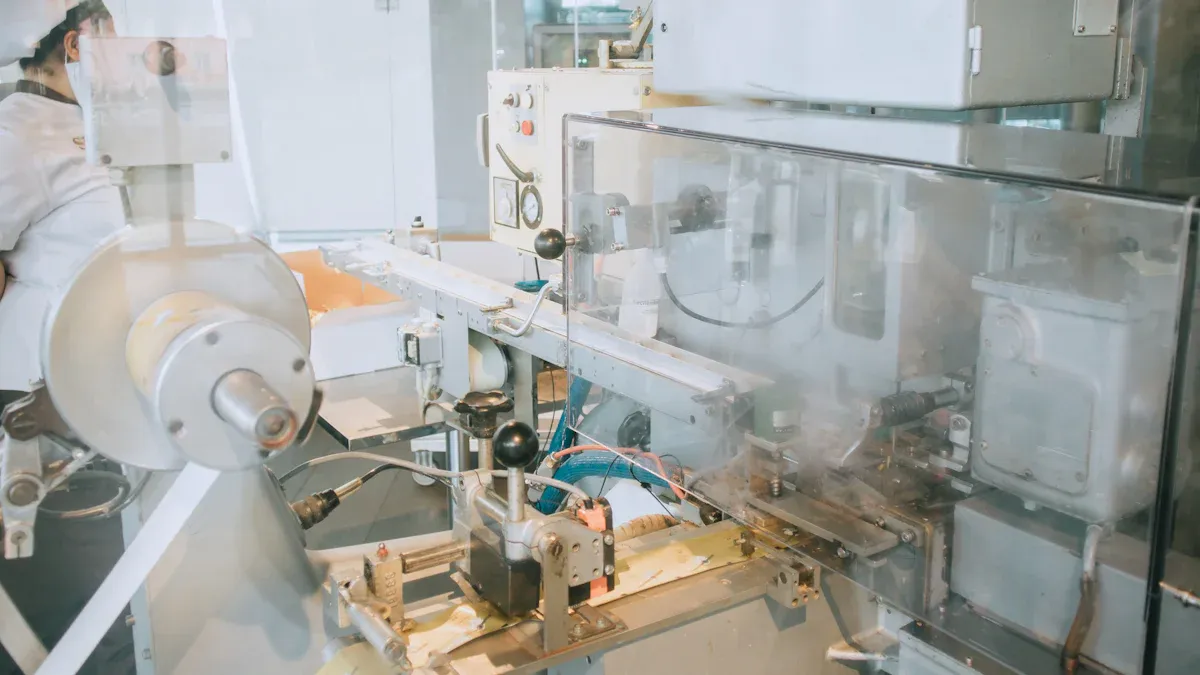
Modern manufacturing demands materials that can withstand extreme conditions while delivering exceptional performance. Advanced polymers have become indispensable in injection molding due to their unique properties. For instance, PEEK offers remarkable heat resistance and mechanical strength, making it ideal for aerospace and medical applications. Similarly, nylon stands out for its durability and flexibility, which are essential for automotive and consumer goods. These materials not only enhance product quality but also meet the growing need for lightweight and efficient solutions in industries.
The adoption of advanced polymers continues to grow rapidly. The polymer microinjection molding market, valued at $1,264.7 million in 2023, is projected to expand at a 10.5% CAGR through 2030. This growth reflects their increasing importance in sectors like electronics, automotive, and telecom.
Traditional materials used in injection molding often fail to meet the demands of modern industries. Metals and basic plastics, for example, lack the flexibility, durability, and resistance required for high-performance applications. These materials struggle under extreme temperatures or exposure to chemicals, leading to product failures or reduced lifespans. Additionally, their heavier weight makes them unsuitable for industries like aerospace and automotive, where lightweight components are critical.
Another challenge with traditional materials is their limited ability to adapt to complex designs. Manufacturing parts with intricate geometries or tight tolerances becomes difficult, resulting in higher waste and production costs. This inefficiency not only affects the quality of the final product but also increases the environmental impact of the manufacturing process.
Advanced polymers have revolutionized injection molding by addressing the limitations of traditional materials. These high-performance plastics offer exceptional strength, heat resistance, and chemical stability, making them ideal for demanding environments. For instance, high-performance thermoplastics like PEEK and PPS are widely used in aerospace and medical applications due to their ability to withstand extreme conditions.
Industries benefit from the lightweight nature of advanced polymers, which improves energy efficiency and reduces transportation costs. In aerospace, for example, using high-performance thermoplastics in aircraft components enhances fuel efficiency and safety. Similarly, in the medical field, biocompatible polymers enable the production of implants and devices that are both durable and safe for patients.
Advanced polymers also support innovation in custom injection molding. Their versatility allows manufacturers to create complex designs with precision, reducing waste and improving product quality. This adaptability has made advanced polymers the leading injection molding plastics for high-performance industries.
The use of advanced polymers in injection molding significantly enhances manufacturing efficiency. These materials enable faster production cycles, better quality control, and reduced waste. Computational models have shown how advanced polymers improve the plasticization phase of the injection process. By optimizing parameters like screw speed and barrel temperature, manufacturers achieve consistent results with minimal errors. Experimental studies confirm that temperature predictions from these models align with actual measurements, differing by less than 5%.
Efficiency improvements are further supported by advanced technologies. For example, real-time monitoring systems and smart sensors provide immediate feedback on critical metrics such as temperature, pressure, and material flow. This data helps manufacturers maintain precision and reduce defects. The table below highlights key efficiency metrics enabled by advanced polymers:
| Efficiency Metric | Description |
|---|---|
| Advanced Materials | High-performance polymers enhance strength, chemical resistance, and biocompatibility. |
| Improved Part Design | Prioritizing quality control reduces waste and production costs. |
| Real-Time Monitoring | IoT integration allows for immediate feedback on temperature, pressure, cycle time, and flow. |
| Smart Sensors | Advanced sensors monitor surface finish, dimension accuracy, and material properties in real-time. |
| Simulation Tools | Virtual prototyping helps predict defects and improve part consistency. |
In addition to these advancements, research in high-performance thermoplastics continues to drive innovation. For example, the ACOMP/CI platform has improved polymer manufacturing by reducing waste and shortening production times. This technology aims to automate polymerization reactions, boosting energy efficiency and competitiveness across industries.
By adopting advanced polymers, you can achieve superior results in injection molding. These materials not only enhance product quality but also streamline the manufacturing process, making them essential for modern industries.

PEEK, or polyether ether ketone, stands out as one of the most advanced polymers available today. Its exceptional material properties make it a top choice for high-performance applications. PEEK exhibits remarkable strength, with a tensile strength ranging from 90 to 100 MPa. This ensures that components made from PEEK can withstand significant mechanical stress without deformation or failure. Additionally, its Young's modulus of 3.6 GPa highlights its rigidity, making it ideal for parts requiring dimensional stability.
Heat resistance is another defining feature of PEEK. It has a glass transition temperature of approximately 143°C (289°F) and a melting point of around 343°C (662°F). These properties allow PEEK to maintain its structural integrity even in extreme thermal environments. For instance, it can operate continuously at temperatures up to 250°C (482°F) without losing performance. Furthermore, its heat-deflection temperature exceeds 260°C at 0.45 MPa, making it suitable for applications where thermal stability is critical.
PEEK also excels in chemical resistance. It resists degradation when exposed to strong acids, alkalis, and organic solvents. This stability ensures that PEEK components remain reliable in chemically aggressive environments, such as those found in industrial processing or medical sterilization. The table below summarizes some of PEEK's key material properties:
| Property | Value |
|---|---|
| Young's Modulus | 3.6 GPa |
| Tensile Strength | 90 to 100 MPa |
| Glass Transition Temperature | ~143 °C (289 °F) |
| Melting Point | ~343 °C (662 °F) |
| Useful Operating Temperature | Up to 250 °C (482 °F) |
| Heat-Deflection Temperature | >260 °C at 0.45 MPa |
| Chemical Resistance | Excellent |
PEEK's unique properties have made it indispensable across various industries. In aerospace, PEEK is used for components like brackets, fasteners, and wingbox covers. These parts benefit from PEEK's lightweight nature and high strength, which improve fuel efficiency and reduce emissions. For example, the OUTCOME project demonstrated PEEK's suitability in aircraft structures, showcasing its potential to enhance energy efficiency.
In the medical field, PEEK has revolutionized surgical procedures. Its biocompatibility allows it to be used in spinal fusion cages, dental implants, and other medical devices. These applications improve patient outcomes by offering durable and safe solutions. Additionally, PEEK's resistance to sterilization processes ensures its reliability in healthcare environments.
The automotive sector represents the largest segment of PEEK demand, accounting for approximately 30% of its global usage in 2023. PEEK is used in engine components, transmission systems, and electrical connectors. Its ability to withstand high temperatures and chemical exposure makes it ideal for these demanding applications. By replacing traditional materials like metals, PEEK helps reduce vehicle weight, improving fuel efficiency and performance.
PEEK consistently outperforms traditional materials like metals and basic plastics in challenging conditions. Its superior tensile strength of up to 100 MPa and high glass transition temperature enable it to maintain performance under mechanical and thermal stress. For instance, experimental results show that carbon fiber-reinforced PEEK (CF-PEEK) has a tensile strength of 425 MPa, significantly higher than CF-epoxy's 311 MPa. This makes PEEK a more reliable choice for structural applications.
PEEK's flame resistance further enhances its appeal. With a limiting oxygen index (LOI) of over 47, it offers excellent fire safety, making it suitable for aerospace and automotive applications. Additionally, its chemical resistance ensures long-term durability in environments where exposure to harsh substances is unavoidable.
Another advantage of PEEK is its dimensional stability. It resists warping and deformation, even under high temperatures or mechanical loads. This property allows manufacturers to produce precision components with tight tolerances, reducing waste and improving product quality. The table below compares PEEK with traditional materials:
| Property | CF-PEEK | CF-Epoxy |
|---|---|---|
| Tensile Strength (MPa) | 425 | 311 |
| Glass Transition Temperature | Higher | Lower |
| LOI (Flame Resistance) | >47 | N/A |
By choosing PEEK for injection molding, you can achieve superior performance, reliability, and efficiency in your products. Its unmatched combination of strength, heat resistance, and chemical stability makes it the ideal material for demanding environments.
Nylon stands out as one of the most versatile resins used in injection molding. Its durability ensures that components can withstand mechanical stress without breaking or deforming. This makes it a reliable choice for parts exposed to wear and tear. Nylon also offers excellent flexibility, allowing it to adapt to various shapes and designs without compromising strength. Its high impact resistance and abrasion resistance further enhance its performance in demanding environments.
Another key advantage of nylon is its cost-effectiveness. It provides a balance between performance and affordability, making it suitable for high-volume production. Nylon resins are widely available, and their processing costs are relatively low compared to other advanced polymers. These properties make nylon a preferred material across industries.
Nylon's versatility has led to its widespread adoption in both consumer goods and industrial applications. In the automotive sector, nylon is used for airbag canisters, engine covers, and lightweight components that improve fuel efficiency. Its heat resistance and chemical resistance make it ideal for vehicle cooling systems and fuel tanks. In the electrical industry, nylon is used to produce tubes for cables, connectors, and circuit breakers, offering excellent insulation and durability.
In textiles, nylon is a popular choice for high-performance fabrics used in activewear, sportswear, and outdoor gear. Its moisture-wicking capabilities and abrasion resistance make it suitable for demanding environments. These diverse applications highlight nylon's adaptability and importance in modern manufacturing.
| Sector | Key Applications |
|---|---|
| Automotive | Airbag canisters, engine covers, lightweight parts, fuel tanks, and vehicle cooling systems. |
| Electrical | Tubes for cables, connectors, circuit breakers, and low-voltage switch gears. |
| Textile | High-performance fabrics for activewear, sportswear, and outdoor gear with moisture-wicking properties. |
When compared to other advanced polymers, nylon offers unique advantages. It is often more affordable for simple, high-volume parts. For example, while POM (polyoxymethylene) has lower processing costs and faster cycles, nylon's flexibility and impact resistance make it a better choice for applications requiring durability. POM may require additional machining for tight tolerances, which can offset its cost benefits in large-scale production.
Nylon also excels in terms of availability and adaptability. Its mechanical strength, chemical resistance, and dimensional stability make it suitable for a wide range of applications. While other polymers like PEEK may outperform nylon in extreme conditions, nylon remains a cost-effective and versatile solution for most injection molding needs.
Emerging advanced polymers such as polyphenylene sulfide (PPS), liquid crystal polymers (LCPs), and polyetherimide (PEI) are reshaping the landscape of injection molding. These materials offer unique properties that surpass traditional resins and thermoplastics, making them ideal for advanced applications in molding. PPS, for instance, exhibits excellent mechanical strength and thermal stability, maintaining its performance above 200°C. LCPs stand out for their high energy absorption and controlled crush characteristics, which are particularly useful in automotive crash-management structures. PEI, known for its exceptional flame resistance and dielectric properties, is widely used in industries requiring high-performance electrical insulation.
Recent market analyses highlight the growing adoption of these polymers. Manufacturers are increasingly investing in research to develop specialized grades that meet the evolving demands of industries like automotive, aerospace, and defense. For example, collaborations between companies such as Solvay and Evonik have led to innovations in nylon alternatives, directly competing with PPS in high-temperature applications.
Each of these advanced polymers brings distinct advantages to injection molding. PPS offers low water absorption and inherent flame resistance, making it suitable for electrical components and industrial equipment. Reinforced grades like PPS GF40, which contains 40% glass fiber, provide enhanced strength for demanding applications. LCPs excel in thermal stability and chemical resistance, allowing them to endure e-coat and paint bake oven temperatures during automotive assembly. Their versatility extends to performance sporting goods and structural reinforcements.
PEI, on the other hand, is prized for its ability to withstand extreme conditions while maintaining dimensional stability. Its flame resistance and dielectric properties make it indispensable in electrical and aerospace applications. Testing data confirms that PEI performs exceptionally well in environments requiring high thermal and mechanical resistance.
The introduction of these advanced polymers expands the possibilities of injection molding. PPS, LCPs, and PEI enable manufacturers to create complex designs with precision while reducing waste. Technical feasibility reports show how tooling actions and draft analyses optimize part design for these materials. For example, PPS’s low shrinkage minimizes defects, while LCPs’ controlled crush characteristics enhance safety in automotive applications.
These polymers also support innovation in industries like defense and aerospace, where components must endure extreme conditions. Their unique properties allow for lightweight, durable solutions that improve energy efficiency and performance. As research investments continue to grow, the adoption of these materials will drive the next wave of advancements in injection molding.

Sustainability is reshaping the future of injection molding. You can now find eco-friendly polymers designed to reduce environmental impact without compromising performance. These materials include biodegradable plastics and recycled polymers, which help lower waste and energy consumption during production. Manufacturers are also adopting bio-based polymers derived from renewable resources like corn starch and sugarcane. These innovations align with sustainability efforts to minimize reliance on fossil fuels.
Efforts to improve sustainability extend beyond material development. Injection molding processes are becoming more energy-efficient through advanced machinery and optimized designs. For example, electric injection molding machines consume less energy compared to hydraulic systems. By reducing energy usage, you contribute to sustainability while lowering operational costs. Additionally, closed-loop recycling systems allow manufacturers to reuse scrap materials, further reducing waste.
Polymer blends and composite materials are revolutionizing injection molding. These materials combine polymers with reinforcement agents like glass fibers or carbon fibers to enhance properties such as strength and resistance. For instance, injection molding of polymer composites involves melting the polymer and injecting it into molds with reinforcement materials. This process ensures high efficiency and repeatability, making it ideal for mass production.
Proper process parameters and mold design play a crucial role in minimizing defects. By optimizing these factors, you can achieve consistent results and improve product quality. Composite materials also enable the creation of lightweight yet durable components, which are essential for industries like aerospace and automotive. Their resistance to heat and mechanical stress makes them a reliable choice for demanding applications.
3D printing is driving innovation in advanced polymers. This technology allows you to rapidly prototype designs, accelerating the development of materials with specialized properties. Industries like aerospace and automotive benefit from 3D printing’s ability to replicate final product characteristics during testing. For example, advancements in polymer strength and heat resistance are evident in these sectors, where performance under extreme conditions is critical.
The adoption of 3D printing is increasing across industries, creating demand for advanced polymers tailored to specific applications. You can use this technology to explore new possibilities in injection molding, such as producing complex geometries with precision. By integrating 3D printing into your workflow, you enhance flexibility and reduce production time, paving the way for innovative solutions.
Advanced polymers have reshaped injection molding, enabling industries to meet modern challenges with precision and efficiency. Materials like PEEK and Nylon deliver unmatched strength, flexibility, and chemical resistance, making them indispensable for aerospace, automotive, and medical applications. Emerging polymers such as PPS and PEI further expand possibilities, offering solutions for extreme conditions and complex designs. Innovations like digital twins and additive manufacturing optimize production, reduce waste, and accelerate time-to-market. As you explore these advancements, you’ll find that ongoing innovation in polymer technologies continues to drive sustainable and transformative growth across industries.
Advanced polymers are high-performance plastics with superior properties like strength, heat resistance, and chemical stability. They are essential in injection molding because they enable the creation of durable, lightweight, and complex components for industries like aerospace, automotive, and medical.
PEEK offers exceptional heat resistance, chemical stability, and mechanical strength. Unlike traditional materials, it performs well in extreme environments, making it ideal for demanding applications. Its lightweight nature also improves energy efficiency in industries like aerospace and automotive.
Yes, nylon is highly versatile. Its durability, flexibility, and cost-effectiveness make it suitable for high-performance applications. It is commonly used in automotive, electrical, and consumer goods industries due to its excellent impact resistance and adaptability.
Many advanced polymers are becoming eco-friendly. Manufacturers now develop bio-based and recyclable polymers to reduce environmental impact. Additionally, energy-efficient injection molding processes and closed-loop recycling systems further enhance sustainability in polymer production.
Yes, 3D printing works well with advanced polymers. It allows you to prototype designs quickly and test materials for specialized applications. This technology accelerates innovation by enabling the creation of complex geometries and reducing production time.